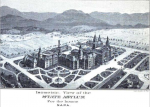Difference between revisions of "Portal:Featured Article Of The Week"
M-Explorer (talk | contribs) |
M-Explorer (talk | contribs) |
||
| Line 1: | Line 1: | ||
{{FAformat | {{FAformat | ||
| − | |Title= | + | |Title= Napa State Hospital |
| − | |Image= | + | |Image= Napa2.png |
|Width= 150px | |Width= 150px | ||
| − | |Body= | + | |Body= In 1872, a site was selected and work began for the erection of the 500-bed, four-story, Gothic-style hospital building. The hospital originated due to overcrowded conditions at the Stockton Asylum, the first State Hospital. The doors of the unfinished entrance of Napa State Hospital opened on Monday, November 15, 1875, to the first individuals, two San Franciscans. |
| + | |||
| + | Initially, 192 acres of land were purchased for $11,506 from Don Cayetano Juarez. These acres were part of the Mexican Land Grant, Rancho Tulocay, received from General Mariano Vallejo. Additional land was acquired over the years bringing the total to over 2,000 acres. The land extended from a wharf on the Napa River to the eastern edge of Skyline Park, allowing for the development of dairy and poultry ranches, vegetable gardens, orchards and other farming operations necessary to make the hospital as self-sufficient as possible. Farming operations ceased in the late 1960's. Napa Valley College, Kennedy Park and Skyline Wilderness Park now occupy most of this land. | ||
| + | |||
| + | The population peaked in 1960 with over 5,000 individuals in residence and then steadily declined with the arrival of psychotropic medications and the development of county based programs. Treatment programs for developmentally disabled residents were operant from October 1968, to August 1987, and from October 1995, to March 2001. [[Napa State Hospital|Click here for more...]] | ||
}} | }} | ||
Revision as of 04:31, 6 May 2013
Featured Article Of The Week
Napa State Hospital
In 1872, a site was selected and work began for the erection of the 500-bed, four-story, Gothic-style hospital building. The hospital originated due to overcrowded conditions at the Stockton Asylum, the first State Hospital. The doors of the unfinished entrance of Napa State Hospital opened on Monday, November 15, 1875, to the first individuals, two San Franciscans.
Initially, 192 acres of land were purchased for $11,506 from Don Cayetano Juarez. These acres were part of the Mexican Land Grant, Rancho Tulocay, received from General Mariano Vallejo. Additional land was acquired over the years bringing the total to over 2,000 acres. The land extended from a wharf on the Napa River to the eastern edge of Skyline Park, allowing for the development of dairy and poultry ranches, vegetable gardens, orchards and other farming operations necessary to make the hospital as self-sufficient as possible. Farming operations ceased in the late 1960's. Napa Valley College, Kennedy Park and Skyline Wilderness Park now occupy most of this land.
The population peaked in 1960 with over 5,000 individuals in residence and then steadily declined with the arrival of psychotropic medications and the development of county based programs. Treatment programs for developmentally disabled residents were operant from October 1968, to August 1987, and from October 1995, to March 2001. Click here for more...
